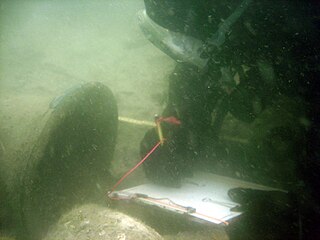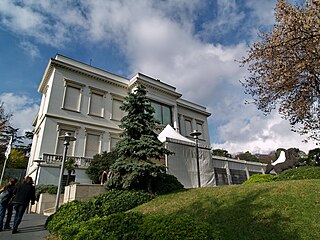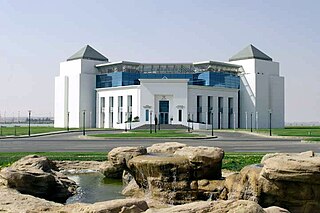Related Research Articles

Maritime archaeology is a discipline within archaeology as a whole that specifically studies human interaction with the sea, lakes and rivers through the study of associated physical remains, be they vessels, shore-side facilities, port-related structures, cargoes, human remains and submerged landscapes. A specialty within maritime archaeology is nautical archaeology, which studies ship construction and use.

The Iraq Museum is the national museum of Iraq, located in Baghdad. It is sometimes mistakenly called the National Museum of Iraq, a recent phenomenon influenced by other nations' naming of their national museums; but The Iraq Museum's name is inspired by the name of the British Museum. The Iraq Museum contains precious relics from the Mesopotamian, Persian and Islamic civilization. It was looted during and after the 2003 Invasion of Iraq. Despite international efforts, only some of the stolen artifacts have been returned. After being closed for many years while being refurbished, and rarely open for public viewing, the museum was officially reopened in February 2015.

The Supreme Council of Antiquities (SCA) was a department of the Egyptian Ministry of Culture from 1994 to 2011. It was the government body responsible for the conservation, protection and regulation of all antiquities and archaeological excavations in Egypt, and was a reorganization of the Egyptian Antiquities Organisation, under Presidential Decree No. 82 of Hosni Mubarak.

A virtual museum is a digital entity that draws on the characteristics of a museum, in order to complement, enhance, or augment the museum experience through personalization, interactivity and richness of content. Virtual museums can perform as the digital footprint of a physical museum, or can act independently, while maintaining the authoritative status as bestowed by the International Council of Museums (ICOM) in its definition of a museum. In tandem with the ICOM mission of a physical museum, the virtual museum is also committed to public access; to both the knowledge systems imbedded in the collections and the systematic, and coherent organization of their display, as well as to their long-term preservation.

The Sabancı University Sakıp Sabancı Museum is a private fine arts museum in Istanbul, Turkey, dedicated to calligraphic art, religious and state documents, as well as paintings of the Ottoman era. The museum was founded by Sakıp Sabancı, and was opened in June 2002. Aside from permanent exhibitions, the museum also hosts national and foreign temporary exhibitions and, hosts cultural events on the weekends.
David Bourke O’Connor is a retired Australian-American Egyptologist who primarily worked in the fields of Ancient Egypt and Nubia. O’Connor is the Lila Acheson Wallace Professor Emeritus at New York University's Institute of Fine Art, the Curator Emeritus of the University of Pennsylvania's Egyptian Museum, and the director emeritus at the Abydos Archaeology expedition in Egypt. O’Connor is most well known for his work in the excavation of the ancient city of Abydos in Egypt since 1967.

Pointe-à-Callière Museum is a museum of archaeology and history in Old Montreal, Quebec, Canada. It was founded in 1992 as part of celebrations to mark Montreal's 350th birthday. The museum has collections of artifacts from the First Nations of the Montreal region that illustrate how various cultures coexisted and interacted, and how the French and British regimes influenced the history of this territory over the years. The site of Pointe-à-Callière has been included in Montreal’s Birthplace National Historic Site since its designation in 1924.

The Imhotep Museum is an archaeological museum located at the foot of the Saqqara necropolis complex, near Memphis in Lower Egypt.

The Museum of Islamic Art (MIA) in Cairo, Egypt is considered one of the greatest museums in the world, with its exceptional collection of rare woodwork and plaster artefacts, as well as metal, ceramic, glass, crystal, and textile objects of all periods, from all over the Islamic world.
The Aga Khan Trust for Culture (AKTC) is an agency of the Aga Khan Development Network (AKDN), a family of institutions created by Aga Khan IV with distinct but complementary mandates to improve the welfare and prospects of people in the developing world, particularly in Asia and Africa. It focuses on the revitalization of communities in the Muslim world—physical, social, cultural, and economic. The AKTC was founded in 1988 and is registered in Geneva, Switzerland, as a private non-denominational philanthropic foundation.

The stone quarries of ancient Egypt once produced quality stone for the construction of decorative monuments such as sculptures and obelisks. These quarries are now recognised archaeological sites. Eighty percent of the ancient quarry sites are in the Nile valley; some of them have disappeared under the waters of Lake Nasser and some others were lost due to modern mining activity.
Gothicmed is a European Union project carried out within the Culture 2000 programme and headed by the Ministry of Culture of the regional government of Valencia, Spain. The aim of the project is to gain further insight into Gothic architecture in the Mediterranean, to connect researchers working separately in different countries, and to disseminate the values of this chapter in architectural history.

The Ministry of Awqaf of Egypt is one of ministries in the Egyptian government and is in charge of religious endowments. Religious endowments, awqaf, are similar to common law trusts where the trustee is the mosque or individual in charge of the waqf and the beneficiary is usually the community as a whole. Examples of waqfs are of a plot of land, a market, a hospital, or any other building that would aid the community.

The Center for Documentation of Cultural and Natural Heritage (CULTNAT) of the Cultural Outreach Sector of the Bibliotheca Alexandrina plays an important and unique role in documenting Egypt's cultural heritage in its tangible and intangible aspects, besides Egypt's natural heritage from protectorates and wildlife. The Center has contributed, for nearly two decades, to documenting and disseminating information related to heritage through the implementation of many projects for digital documentation of Egyptian heritage using the latest information technology technologies in cooperation with specialized local and international bodies and the center is keen to increase awareness of cultural and natural heritage and the Egyptian identity by benefiting from various media channels. CULTNAT also builds the capacities of workers in the field of documenting and preserving civilizational and natural heritage.

The Ephesos Museum in Vienna displays antiquities from the city of Ephesus, in modern-day Turkey. Begun in the late 19th century, the collection includes original works of sculpture and architecture, and belongs to the Kunsthistorisches Museum.
The Archeological Map of Egypt is an archeological Geographical Information System (GIS) documenting Egyptian archaeological sites at the national, site, and monument levels.
The Prince Amr Ibrahim Palace is a historical building in Cairo's Zamalek island, which is used as the Egypt's first ceramics museum, the Museum of Islamic Ceramics and as an art center.

The Ministry of Tourism & Antiquities is the Egyptian government organization which serves to protect and preserve the heritage and ancient history of Egypt. In December 2019 it was merged into the Ministry of Tourism with Khaled El-Anany retaining his function.

Luigi Vassalli was an Italian Egyptologist and patriot.

The National Museum of Egyptian Civilization (NMEC) is a large museum in the ancient city of Fustat, now part of Cairo, Egypt. The museum partially opened in February 2017 and will display a collection of 50,000 artefacts, presenting Egyptian civilization from prehistoric times to the present day.
References
- 1 2 Nevine El-Aref (2005-12-15). "Surfing Islamic Art". Al-Ahram Weekly. Archived from the original on 2008-09-13. Retrieved 2008-09-09.
- 1 2 Nevine El-Aref (2002-03-28). "Tourist Trail Round the Med". Al-Ahram Weekly . Archived from the original on 2008-09-15. Retrieved 2008-09-09.
- ↑ MAMLUK ART -The Splendour and Magic of the Sultans (Region: Cairo and Nile Delta) trail exhibit (photos by: Sherif Sonbol)
- ↑ "Museum With No Frontiers - Discover Islamic Art". National Museums Scotland. Retrieved 2008-09-09.
- ↑ Frances Booth (2007-10-05). "Virtual Museum Showcases Shared Heritage". The Telegraph . Retrieved 2008-09-09.[ dead link ]
- ↑ Bernau, Nikolaus (2007-07-11). "Islamische Kunst am Mittelmeer". Berliner Zeitung . Retrieved 2008-08-29.
- ↑ "The Arab view of its shared history at Sharjah Maritime Museum" Archived 2015-05-25 at the Wayback Machine , Khaleej Times , 2015-05-21. Retrieved 2015-05-24.
- ↑ Fayza Hassan (1999-07-22). "Down the Yellow Brick Road". Al-Ahram Weekly. Archived from the original on 2008-09-14. Retrieved 2008-09-09.